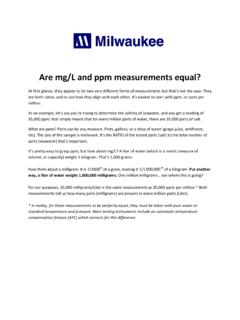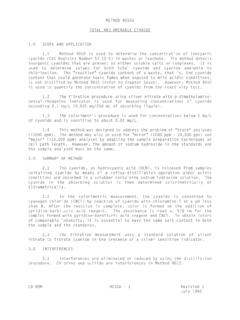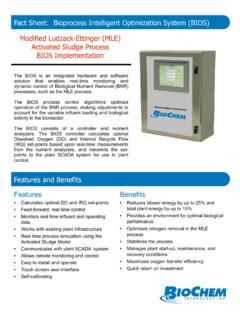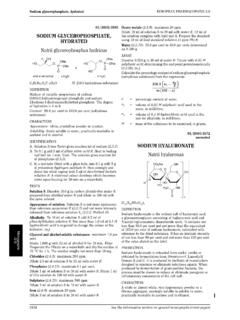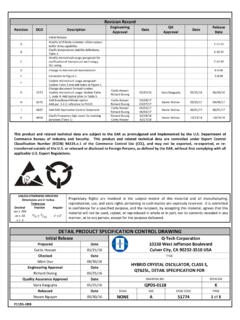Transcription of Method for Determining HCl and Cl2 Emissions in …
1 2009, TestAmerica Laboratories, Inc. All rights reserved. TestAmerica & Design are trademarks of TestAmerica Laboratories, Inc. Fundamentals of the Method for Analysis of Particulate Matter and Anions in Method 0050 Train Samples An EPA Method 0050 HCl/Cl2 Train (SW-846 Method 0050) configuration is used to collect samples from stack gas for the assessment of particulate matter, hydrogen chloride (HCl), and chlorine (Cl2). Other acid gases such as hydrogen fluoride (HF), hydrogen bromide (HBr), nitric acid (HNO3), nitrous acid (HNO2), nitrate (NO3-), and nitrite (NO2-) Emissions can also be measured.
2 The Method 0050 sample components are collected from the train after the completion of each run. A particulate filter with an attendant acetone probe rinse is collected for the determination of stack gas particulate. A composite sample containing the contents of the first three (3) impingers of the train is collected. The first impinger is empty at the beginning of the sampling run, and serves as a condensate knockout impinger (CKI) for the collection of the majority of the condensate formed in the train. The second and third impingers are initially charged with 100 mL each of H2SO4. These acidic impingers allowed for the dissociation and collection of HCl and other acid gases from the stack gas.
3 A second composite sample of the fourth and fifth impingers is collected, each initially charged with 100 mL of NaOH, and analyzed for Cl- (and F-, NO3-, and NO2-). The main feature of this assessment is the determination of chlorine gas separately from HCl acid gas. Chlorine gas (Cl2) present in the Emissions does not desorb in the acidic H2SO4 medium. Chlorine passes through the first three impingers as an unreacted gas, but is trapped by chemical reaction when it comes in contact with the NaOH solution. The reaction is as follows: Both of the chlorine products of this reaction dissociate into their respective base forms (Cl- and OCl-).
4 Consequently, the Method 0050 sampling train collects the Cl2 gas ( NaOH impingers) as a separate OHClOClOHCl NaOH222 Method 0050/ Method 26 or 26A Method for Determining HCl and Cl2 Emissions in Stack Gas 2009, TestAmerica Laboratories, Inc. All rights reserved. TestAmerica & Design are trademarks of TestAmerica Laboratories, Inc. species from HCl gas ( H2SO4). Note that both the H2SO4 and the NaOH impinger composites are analyzed in the lab for chloride (Cl-) anion content, but the HCl and Cl2 off-gas concentrations are acquired from the data. The NaOH samples are treated in the laboratory (not in the field) with sodium thiosulfate (Na2S2O3) as a reducing agent to convert the hypochlorite (OCl-) ion to chloride (Cl-).
5 Conversion of OCl- to Cl- is performed to ensure that an accurate assessment of the Cl2 content is made. The chemical equation for the conversion of OCl- is as follows: Oxidizing species like hypochlorite (OCl-) are chemically reduced by thiosulfate to convert it to the chloride anion. By the addition of thiosulfate, the measured concentration of chloride is equal to the exact concentration of chlorine that was trapped by the NaOH impinger solution with no possible bias due to a partial conversion. The H2SO4 (condensate samples) and NaOH impinger samples are analyzed by ion chromatography using SW-846 Method 9056/9057.
6 The calibration range of the lab application extends from mg/L to 20 mg/L for all of the target anions. In order to quantify the target anions, several analyses are typically conducted at different dilution factors that range from 1 to 10, since the various anions are present at several concentration levels. Dilutions are performed to bring the sample concentrations within the instrument calibration range, as well as to overcome any deleterious matrix effects. Optimum values are chosen for reporting, with the lowest detection limits achievable, reported in each case. The final data for each anion are based on analyses that are within the calibration range of the instrument.
7 OHCl4SO2OH2 OCl4OS224232 2009, TestAmerica Laboratories, Inc. All rights reserved. TestAmerica & Design are trademarks of TestAmerica Laboratories, Inc. SAMPLE PRESERVATION AND HOLDING TIMES The holding times and preservation techniques are either those recommended in Title 40 CFR Section , Table 11, "Required Containers, Preservation Techniques, and Holding Times," or those presented by EPA in Table 3-1 of the Handbook - Quality Assurance/Quality Control (QA/QC) Procedures for Hazardous Waste Incineration (EPA-625/6-89-023). The NaOH impingers should always be individually checked for pH by using pH test strips at the conclusion of each sampling run.
8 The pH should be maintained above pH = 9 during the run, otherwise Cl2 will not be trapped by the solution, and the results will be biased low. Measurement Matrix Preservationa Holding Timeb Particulate Matter Particulate Filter None None Hydrogen Chloride and Chlorine (HCl & Cl2) Sodium Hydroxide pH > 10 28 days to analysis Sulfuric Acid pH < 2 28 days to analysis Hydrogen Fluoride (HF) Sodium Hydroxide pH > 10 28 days to analysis Sulfuric Acid pH < 2 28 days to analysis Hydrogen Bromide and Bromine (HBr & Br2) Sodium Hydroxide pH > 10 28 days to analysis Sulfuric Acid pH < 2 28 days to analysis Hydrogen Nitrate and Hydrogen Nitrite (HNO3 & HNO2)
9 Sodium Hydroxide Cool, 4oC 2oC, pH > 10 28 days to analysis Sulfuric Acid Cool, 4oC 2oC, pH < 2 28 days to analysis Sulfuric Acid (H2SO4) Sodium Hydroxide Cool, 4oC 2oC, pH > 10 28 days to analysis Sulfuric Acid N/A N/A Phosphorous Acid (H3PO3) Sodium Hydroxide Cool, 4oC 2oC, pH > 10 28 days to analysis Sulfuric Acid Cool, 4oC 2oC, pH < 2 28 days to analysis a CPT samples requiring refrigeration will be preserved on ice from the time of collection through delivery to the analytical laboratory. b Holding times are calculated from the date of collection.
10 Method 0050/ Method 26 or 26A HCl and Cl2 Emissions in Stack Gas 2009, TestAmerica Laboratories, Inc. All rights reserved. TestAmerica & Design are trademarks of TestAmerica Laboratories, Inc. Sodium Thiosulfate Addition to N Sodium Hydroxide Impingers: In the Field or In the Lab? In an effort to optimize service to our customers, TestAmerica has reviewed the sampling and analysis objectives regarding Method 0050 (also Method 26A) to provide recommendations of best practice. The particular issue before us is the addition of sodium thiosulfate (Na2S2O3) to the sodium hydroxide (NaOH) impinger composite to achieve the complete conversion of the impinger species to chloride (Cl-).

